
While the Big Apple is chockfull of globally renowned landmarks, none of which is as synonymous with the city as the Statue of Liberty. Erected in 1886 at Liberty Island as a gift by France to mark the centenary of US independence, the 93-meter-tall sculpture has captured the imagination of millions ever since. So much so in fact, that throughout the years, hundreds of replicas of the famed statue were created all over the world, paying tribute to this NYC icon, each of which by its own unique way.
Given the Statue of Liberty’s country of Origin, France, where it was first fabricated and then transported to NYC for reassembly, it is no surprise that the French capital is home to no less than 5 replicas of the famous monument.
The third largest island along the Seine River segment of Paris, the manmade Île aux Cygnes was originally constructed to provide an extra support for the pont de Grenelle Bridge. Besides its structural role, the 850-meter-long and 11-meter-wide artificial island is also home to a 11.5-meter-tall replica of the Statue of Liberty. Created by Frédéric Auguste Bartholdi, the same sculpturer who designed the original statue, the bronze downsized replica was given in 1889 by the Parisian expat community of New York as a gesture for the 100th anniversary of the French Revolution.
While initially the sculpture was facing eastwards towards France’s Presidential Palace, it was repositioned westwards during the World Fair of 1937 so that the statue’s gaze would be directed towards her trans-Atlantic counterpart. The statue has stood in its mid-river location for over a century, excluding a brief moment, when it was shipped to Tokyo and placed in Odaiba Island to celebrate and promote Japan-France relations. After the French monument was returned to its homeland, a locally built replica (also featuring in the article) was situated at the exact same place.
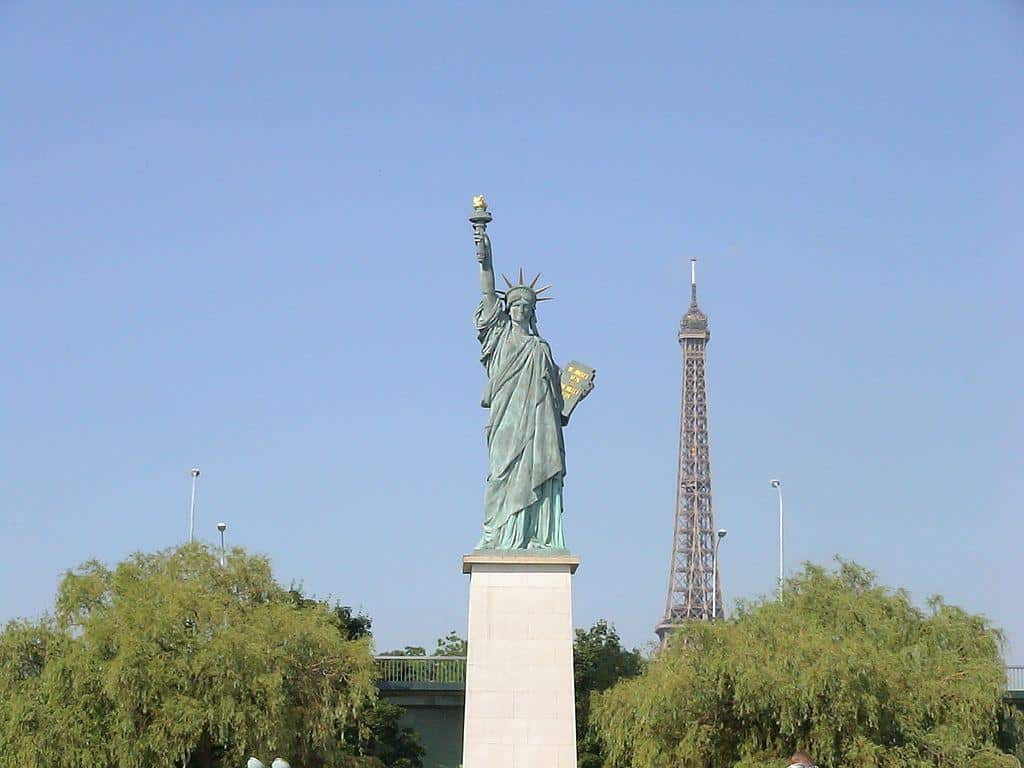
The Parisian replica of the Statue of Liberty on the backdrop of the Eiffel Tower
photography by: V. Gubina/ Wikimedia Commons
With roughly 200 replicas across 39 states, the Statue of Liberty’s home-country is also the undeniable world leader in the number of nationwide copycats.
Amid the typical suburban landscape of Memphis, Tennessee, lies the Statue of Liberation Through Christ, which as its name implies, replaced some of the statue’s original features with Christian symbolism.
The brainchild of pastor Alton Williams from the nearby World Overcomers Church, the modified sculpted lady of Memphis clutches a giant cross instead of the iconic torch while also carrying the Ten commandments tablets with her left hand. Additionally, her crown is vividly gold with the word “Jehovah” inscribed on its base.
Measuring 72 feet or 22 meters from the tip of its cross to the pedestal’s bottom, the unusual statue cost more than 250,000 USD to construct, most of which came through donations of church members. The moment the replica was unveiled in 2006, it immediately sparked a great deal of controversy as many people throughout the country deemed the Christianization of an otherwise secular landmark as offensive and overly whimsical.
Nevertheless, according to Alton, whose statue appears to have a sad facial expression, the monument was intended to protest against what he defines as the increasing godlessness in America, which sadden many across the Bible-Belt region of the country.
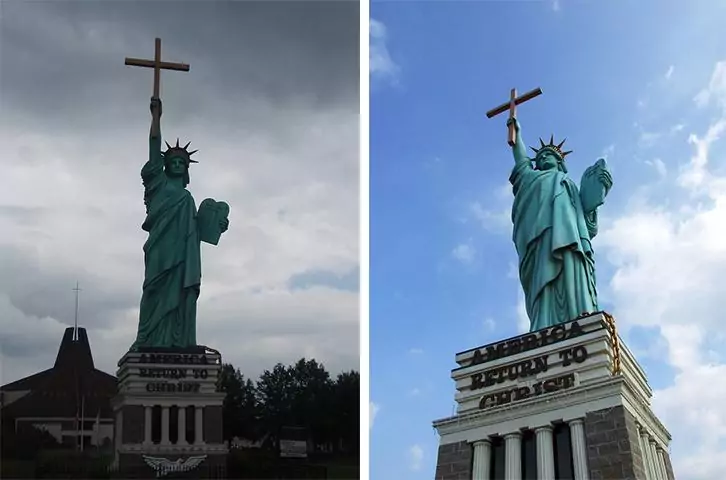
The Statue of Liberation Through Christ in Memphis, Tennessee
photography by: Joel Kramer and Joseph Novak/ Flickr
Often dubbed as the Paris of South America, little do people know that Buenos Aires also qualifies as the continental version of New York as well. Not only because of the city’s hundreds of high-rises, but also thanks to a pair of monuments modeled after their famous counterpart in the north.
Well-hidden in Barrancas de Belgrano Plaza, the Argentine replica of the Statue of Liberty is ninety meters shorter than the original 93-meter-tall sculpture. However, what this replica lacks in size it more than makes up for in its age, as it was inaugurated in October 3, 1886, 25 days before its American counterpart. By now you probably wonder how is it even possible? The truth is, that this replica was sculpted by the same artist who created the original statue, Frédéric Auguste Bartholdi, using cast iron instead of copper.
The statue was originally purchased by Buenos Aires municipality, and few years after its inception was painted with greenish hue to resemble its 25-day younger sister. Interestingly, this sculpture is not the only New-Yorker in town, as Manhattan Club Grand Café in Av. Cabildo boasts the Chrysler Building’s iconic spire, reaching a 30 meter height.
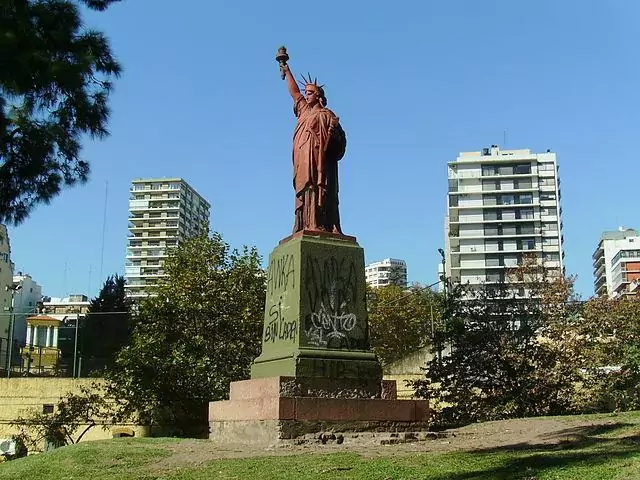
The bronze-colored replica of the Statue of Liberty in Buenos Aires
photography by: Canopus49/ Wikimedia Commons
As its name suggests (daiba – battery/fort in Japanese), the artificially-built island of Odaiba at Tokyo Bay was originally designated as a defensive measure against possible naval invasion. Over the years, the island was expanded and developed into a commercial district where all sorts of recreational activities take place.
And so, it was chosen as the ideal location to accommodate the aforementioned statue from Île aux Cygnes between 1998 to 1999, to celebrate the Japan-France friendship. What the organizers couldn’t anticipate however is the sheer enthusiasm over the Parisian replica by the locals, so much so, that a year after the sculpture made its way back to Paris, it was replaced by a permanent brand-new replica.
At a height of 12.25 meters, the Tokyo’s Statue of Liberty is only one-seventh the size of its original counterpart. Curiously, despite being far eclipsed by its source of inspiration, the Japanese facsimile was positioned in a specific location, with the city’s Rainbow Bridge and skyscrapers on the background, creating the false impression that the statue is far more massive than its actual size.
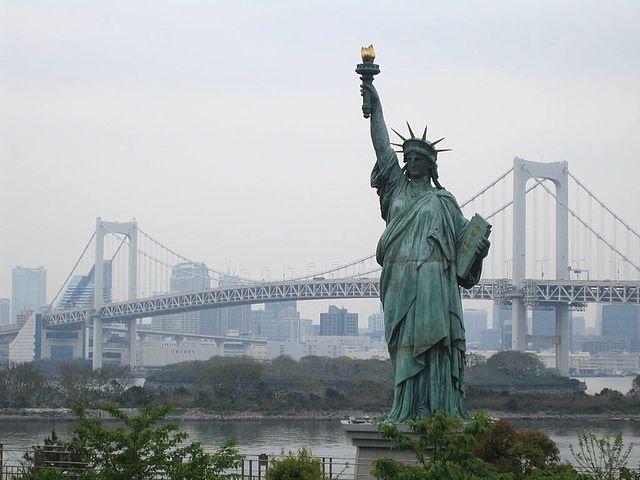
Odaiba's Statue of Liberty bears an uncanny resemblance to NYC original setting
photography by: Ichtrinken/ Wikimedia Commons
Relative to its modest size, the Catalonian town of Cadaqués along the Mediterranean coast is jam-packed with countless sites to explore, as for decades it was regularly frequented by famous artists who saw it as an inspirational place. One of whom was the globally renowned artist, Salvador Dali, who during his childhood spent a great deal of his time at the townlet, and later, as an adult, purchased a vacation house at the neighboring village of Portlligat, which nowadays serves as a museum.
Known for his unusual and surreal style of art, Dali also created in 1972 his own version of the Statue of Liberty, and as you can probably imagine, it has every bit of eccentricity we all associate with Dali. Unlike the American Lady Liberty, Dali’s protagonist holds two torches aloft as if she was a cheerleader. While the original statue resides at the gardens of Vascoeuil Castle in France, Peter Moore, Dali’s right-hand man, donated a copycat of the replica to Cadaqués as a gesture for the artist’s deep affinity with this coastal town. The sculpted lady was placed atop a small tourist office in 1994, and ever since, it was occasionally disfigured following regional protests.
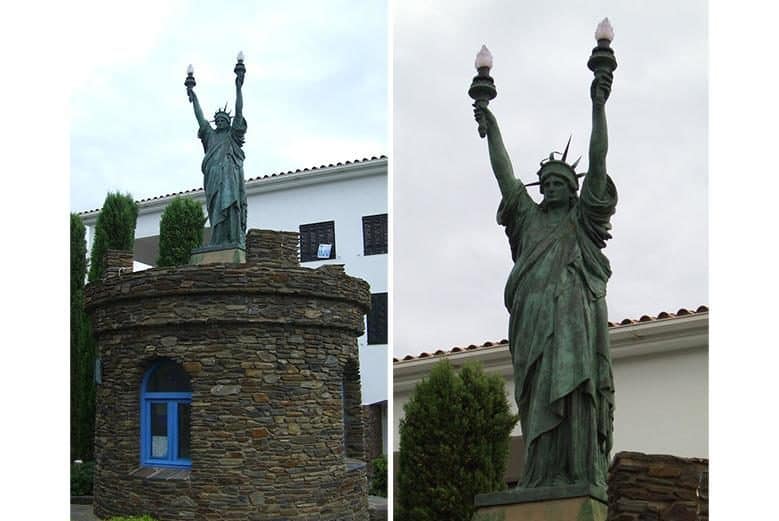
Salvador Dali's replica of the NYC's statue in Cadaqués, holding two torches instead of one
photography by: INDALOMANIA/ Wikimedia Commons
Considered as the birthplace of the modern English language, Leicester is the largest city across the East Midlands region of England. More than a decade before the local football club rose to fame after winning the Premier-League championship for the first time, the city’s Filbert Street Stadium was demolished and relocated further southwards. Apparently, for almost a century, fans who were making their way to the former stadium were greeted by a whitish replica of the Statue of Liberty, which also became their unofficial talisman.
This quaint landmark of Leicester was first-conceived by the Lennards shoe factory’s directors, who upon their return from a business travel to NYC in 1919, decided to embellish their brand-new industrial complex with a replica of the famed statue after being deeply impressed by its iconic role. Sculpted by a local artist named Joseph Herbert Morcom, the 5.8-meter-tall replica was made of lightweight plaster and placed on top of the shoe factory, which soon after was rebranded as the Liberty Shoe Company.
The art-deco style factory was ultimately demolished in 2003, yet as a result of a public outcry, the much-revered statue was restored in 2008 and found a new close-by home, amid a traffic island across the Soar River. The replica overlooks its former location, at the intersection of Raw Dykes Rd and Walnut St, now occupied by a somewhat generic residential building.
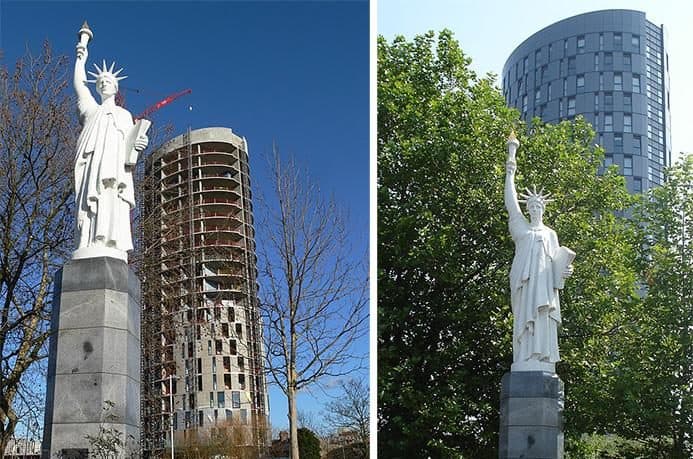
The ultra-white replica of Lady Liberty in Leicester
photography by: Mat Fascione and Lynn Yates/ Wikimedia Commons
Located about ten kilometers from the Gaza Strip, the remote town of Netivot in southern Israel is first and foremost a home for a thriving community of ultra-orthodox Sephardic Jews. For decades, the only site throughout the city that would come remotely close to being a tourist attraction was the tomb of Baba Sali, a Morocco-born religious leader who allegedly possessed supernatural powers of healing.
During the late 2010’s and early 2020’s, a local real-estate developer named Oded Shriki was determined to change his hometown’s reputation, when he erected a series of replicas of famous monuments across Netivot. Alongside his “Paris Center” with its 32-meter-tall replica of the Eiffel Tower, he also constructed a commercial center next to the central train station, where he placed a roughly 6-meter-tall version of the Statue of Liberty in the middle of a public parking lot.
In contrary to her distant and famous counterpart in Liberty Island, Netivot’s crowned lady is bronze-colored and clutches a sculpted apple. The appley figure with the number 15 inside curiously serves as the logo of the surrounding “Manhattan 15” real-estate project, which as you probably guessed by now, was inspired by NYC’s “Big Apple” moniker.
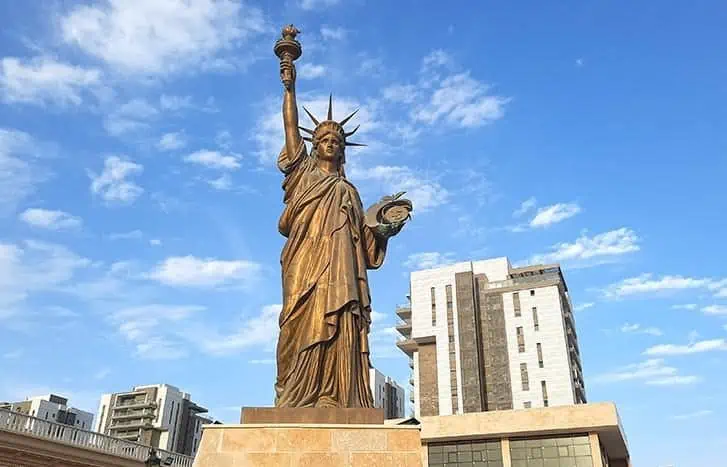
Netivot's apple holding Statue of Liberty
photography by: Omri Westmark
If an unsuspecting passerby came across the Kafka’s Sword statue at the backyard between the NextLiberty Theater and Graz opera building, he would most probably mistake it with an electricity pylon. Created in 1992 by the artist Hartmut Skerbisch to mark the 500th anniversary of the discovery of America by Columbus, the Lichtschwert as it is locally named, is probably the furthest a Statue of Liberty’s replica ever deviated from its original source of inspiration.
While only after a few glances this skeletal structure might ring familiar, it actually has far more in common with its New York’s counterpart that one initially assumes. The replica is in fact a 1:1 representation of the statue framework, entirely stripped of its copper crust, the same way it was designed by Gustav Eiffel back in the 19th century. Where this oddly shaped replica does differ are the objects Lady Liberty holds with her hands.
Instead of the torch and tablet, the Graz-based statue holds a sword and an orb, a gesture to Franz Kafka’s “The Stoker”, a short story as part of “Amerika” Novel where Kafka wrote the following words: “Her arm and the sword were raised like in recent days, and the free winds blew about her form”.
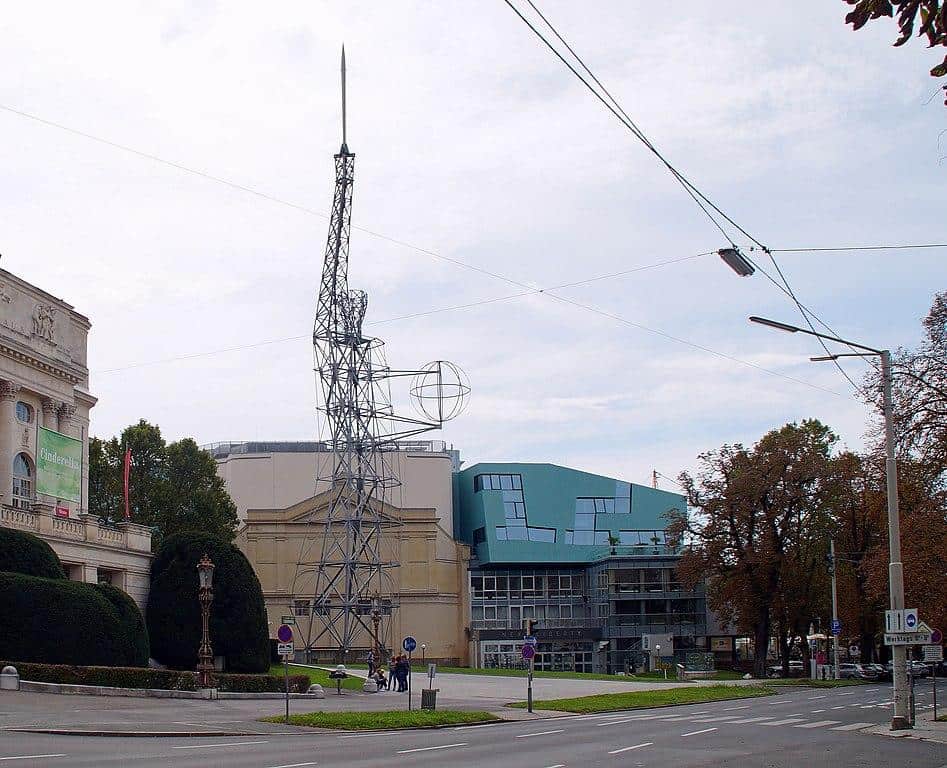
The Statue of Liberty's replica in Graz, aka the Kafka's Sword statue
photography by: TheRunnerUp/ Wikimedia Commons